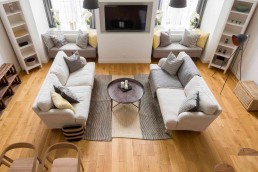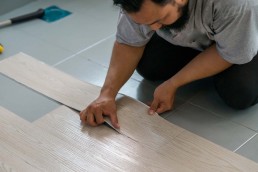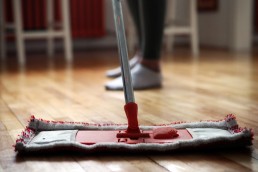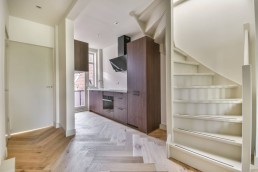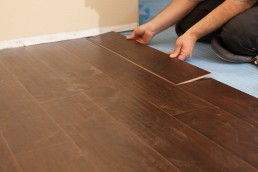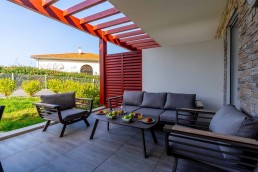Pros and Cons of Natural Hardwood Flooring
When considering putting any type of flooring in your house, its important to consider the pros and cons each type of flooring. For Hardwood Flooring, there are many pros and cons to consider, for example, hardwood floors can work in many types of rooms. This blog will go over some of the pros and cons related to Hardwood Flooring, and will give you more to consider about Hardwood Flooring.
Pros of Hardwood Flooring
Durability
One of the main reasons that drives people to purchase Hardwood Flooring, is its durability. Hardwood has the ability to be refinished and sanded down to give the hardwood a new fresh look. Having the ability to refinish the flooring can save you thousands of dollars, instead of having to install new floors, you can just give them a new, refreshed looked.
Hardwood Flooring is Easy to Maintain
Having floors that are low maintenance can be a large selling point for many people. Hardwood floors require very little maintenance, however they do need to be cleaned regularly like most floors. If you are able to sweep, vacuum, and mop regularly, the floors will hold their integrity and increase their life span. Interested in learning more about how to properly clean hardwood? Learn more here.
Endless Styles
If you are picky when it comes to your flooring, one of the many pros to hardwood is that they have endless options. There are many different natural wood options, that create various different styles and looks for your flooring. If you want to see some of the options we have for hardwood, make sure you come by our showroom to see the endless options!
Cons of Hardwood Flooring
Discoloration
If in direct sunlight, some types of hardwood can start to become discolored. Because of this, you may have to refinish your flooring early than you would like
Water Damage
One of the common complaints about hardwood is if water is left on hardwood for to long, it can damage the flooring and cause it to start peeling or become worn out. So if you experience flooding in a specific room, or have pets that are constantly spilling water in areas from their water bowl, you may not want to put hardwood in those rooms.
Interested in learning more about the Pros and Cons of Hardwood? Call or visit our storefront where a team member can walk you through the different options, and determine what's best for you and your project.
Pros and Cons of Luxury Vinyl Flooring (LVP)
Over the past few years, Luxury Vinyl Flooring (LVP) has gained much traction. One of the main reasons people have been leaning toward Luxury Vinyl (LVP) is because of its affordability of it compared to other options such as hardwood.
Pros of Luxury Vinyl
Easy to Install
LVP is very easy to install. Because of how straightforward the installation is, many people opt to try installing the flooring themselves. This helps reduce the overall cost of purchasing the flooring, and also you are able to install them on your own schedule.
Durability
Luxury Vinyl Flooring very durable flooring option for both residential and commercial installations. Many are waterproof, which means they can be installed anywhere, including wet areas like bathrooms, kitchens, laundry rooms, and basements, while others are water-resistant. They also resist other things like moisture, mold, mildew, stains, scratches, and scuffs.
Luxury Vinyl Flooring has Unique Designs
With Luxury Vinyl Flooring, the design options are endless. There are thousand of options when it comes to designs for LVP, which ensures you are able to find your dream design for you floors.
Cons of Luxury Vinyl
May not do well in Sunlight
Depending on the brand and quality of Luxury Vinyl that you go with, some of the cheaper brands do not do well in sunlight. When purchasing LVP its important to do your research on what brand you are using, and look at the reviews to ensure the quality is good.
LVP can be hard to remove
Once the Luxury Vinyl is installed, it can be hard to remove if you change your mind. This is due to the adhesive glue used to keep them in place.
How To Clean Hardwood Floors
Sweep or Vacuum the Hardwood Floors
Regardless of what type of hardwood floor you have, the first step you should take when trying to clean your floors is to sweep or vacuum your floors. Regardless if you are cleaning your floors or refinishing them, this should be the first step. Using a regular broom or vacuum tends to do the trick, but you can also you a microfiber dust mop, that can remove excess dust and help remove scratches on the floor. When vacuuming hardwood floors, turning the brush rolls off is very important. This will help prevent them from scratching the floors. Hardwood floors can hide certain types of dirt differently than carpet, so its important to sweep or vacuum regularly. 
Mopping the Floors
When mopping hardwood flooring, it is important to ensure you wring out the majority of the water before starting to mop. Too much water can result in the water damaging the floor. Furthermore, be sure to go over every spot multiple times; this is to help ensure that there are no water spots left on the hardwood, as this can result in damaging the surface. Steaming cleaning your floors is typically not encouraged for hardwood floors. Steam cleaning it can dull and ruin the finish of your floors, which can be pricey to repair. Lastly, when using floor cleaners, make sure you use hardwood floor cleaners specifically, avoid tile cleaners and vinyl cleaners.
Giving Your Floors a Refreshed Look
Keeping your floors clean is the first step, but keeping them looking fresh and removing the occasional scratch and dullness is another thing. You can use a liquid scratch concealer that you put on your floor after cleaning them. This will create a permanent seal on your floors that doesn't come off during cleaning. You can also restore your floors and shine them by using any wood floor polish. This will help protect your floor from any wear and tear, and also help reduce the number of scratches.
Want to learn more about taking care of hardwood floors, or thinking of switching to hardwood? Connect with a team member today, and we would love to help you with the next steps!
Where To Use Tile Flooring And Why
Choosing the right flooring for your home is crucial to its aesthetics and functionality. Tile flooring, with its durability and great appeal, is a popular choice for many homeowners. However, deciding where to install tile flooring in your house is equally important.
-
Kitchen
The kitchen is a natural fit for tile flooring. Its resistance to moisture, easy maintenance, and durability make it perfect for the high-traffic area. Spills, splashes, and frequent cleaning are part of daily life in the kitchen, and tile flooring can easily handle them. Whether you opt for ceramic, porcelain, or stone tiles, you'll find various design options to complement your kitchen's style.
-
Bathroom
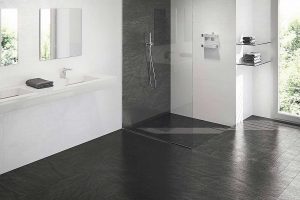
Tile flooring in bathrooms is a classic choice. Their moisture-resistant properties are key in a space where water is often present. Porcelain or ceramic tiles work particularly well here, offering both style and practicality. Their smooth surfaces are easy to clean, and they can withstand the daily rigors of a bathroom environment.
-
Entryway and Mudroom
Entryways and mudrooms are high-traffic areas that are frequently exposed to the elements. Tile flooring is an excellent choice in these spaces because it can endure the wear and tear of shoes, boots, and wet coats. It also makes cleaning up dirt and debris a breeze, ensuring your home stays tidy.
-
Laundry Room
The laundry room is another area where tile flooring shines. Spills from detergents and water leaks from washing machines are common occurrences. The moisture resistance of tile flooring can help prevent water damage to your home's structure. Additionally, it's easier to clean up any detergent or bleach spills on tile compared to other flooring materials.
-
Basement
Basements can be prone to moisture issues, making it a wise choice. It's a barrier against moisture seeping through the concrete slab, preventing mold and mildew growth. While carpet or laminate can be used in basements, it provides added peace of mind in an area that is susceptible to humidity and potentially flooding.
-
Outdoor Spaces
 Many homeowners are now extending the use of tile flooring to outdoor spaces such as patios, decks, and pool surrounds. Porcelain or natural stone flooring can create an elegant and durable outdoor living area.
Many homeowners are now extending the use of tile flooring to outdoor spaces such as patios, decks, and pool surrounds. Porcelain or natural stone flooring can create an elegant and durable outdoor living area.
-
Living Areas
It is not limited to high-moisture or high-traffic areas. In some living areas, such as the dining room or living room, it can make a great impression. These spaces can benefit from the durability and design versatility of tile flooring. They can look similar to natural wood or stone while offering easier maintenance.
Choosing where to install tile flooring in your house involves a thoughtful consideration of practicality and aesthetics. Whether you're prioritizing durability in high-traffic areas, moisture resistance in wet spaces, or simply adding a touch of timeless elegance to your living areas, tile flooring can be a versatile and functional choice. With the wide variety of materials, colors, and patterns available, you can find the perfect tile flooring to suit your needs and style.
Reasons To Chose Luxury Vinyl Flooring
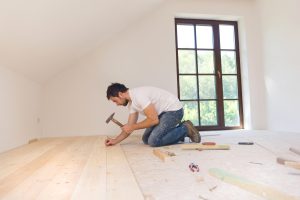 LVP is engineered to be incredibly durable, making it suitable for high-traffic areas and even commercial spaces. It's resistant to scratches, dents, and moisture, making it an ideal choice for kitchens, bathrooms, and entryways where accidents are more likely to occur. This durability ensures that your investment will stand the test of time, looking as luxurious and pristine as the day it was installed.
LVP is engineered to be incredibly durable, making it suitable for high-traffic areas and even commercial spaces. It's resistant to scratches, dents, and moisture, making it an ideal choice for kitchens, bathrooms, and entryways where accidents are more likely to occur. This durability ensures that your investment will stand the test of time, looking as luxurious and pristine as the day it was installed.
Luxury Vinyl Flooring is a great option nonetheless. They are one of the easiest floors to maintain and they can last a significant amount of time. Walking on luxury vinyl flooring is a comfortable and quiet experience, making it an excellent choice for bedrooms and living areas where comfort matters. LVP comes in many different patterns, colors, and textures. It can match virtually any design concept or theme, from rustic to modern and everything in between.
LVP is a composite flooring type that was originally designed for commercial applications making it extremely durable. While luxury vinyl plank has now stormed the residential market, the exceptional quality and hard-wearing surfaces have remained the same except to create better looks that suit home use. We recommend choosing something you will love for decades because you're likely to outgrow your taste before you'll ever wear out this flooring!

The installation process can significantly impact the overall cost of your flooring project. Luxury vinyl flooring is very well easy to install, which saves a lot of time and money. It can often be installed directly over existing flooring, eliminating the need for expensive and time-consuming. However you should consult a professional for their opinion.
Luxury vinyl flooring has redefined what it means to have a luxurious and stylish interior. With the ability to replicate the look and feel of natural materials like hardwood, stone, and tile. It is widely used as people have realized its durability, cost-effectiveness and altogether luxurious look. The wide range of styles and patterns available ensures a luxury vinyl flooring option to suit every design preference.
5 Reasons Why You Should Choose Hardwood Flooring
Hardwood flooring can make your next home project that much more exciting!
Many factors make people lean towards hardwood floor, but there are 5 common reasons.
- Many factors make Hardwood Flooring a go-to option for many people, and one of the main reasons is its cleaning ability. Unlike carpet, there is no dirt or germs that can hide in the carpet, as long as you sweep and mop on occasion, the floor will stay clean. Sweeping and mopping with a damp mop are all you need for general wood maintenance. Spot cleaning can be done with gentle cleaners made for hardwood flooring. You can even vacuum hardwood floors, but choose a vacuum without a beater bar or one with a hard floor mode that doesn’t engage the bar.
- Hardwood Flooring is timeless, and can be used in any areas whether its a bedroom, bathroom, kitchen, living room, or even a dining room. Hardwood flooring can even be used in basements, because they can be more water resistant than most other flooring options.
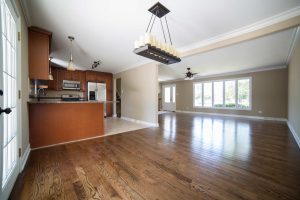
- Hardwood floors wear very well. Whether you have pets, kids, or just yourself walking around your house, hardwood floor can be very durable. If you use proper protectant for floor sealer, the floors can last years.
- Hardwood floors are able to be refinished upwards of 7 times before needing to be replaced! This makes hardwood life span significantly longer due to being able to be refinished, which can make them look brand new again!
- Hardwood floors hold up well with pets! Whether you have a dog that sheds, pet that are messy eaters, with hardwood floor it makes the clean up easier! With the proper protectant and care, you hardwood floor can hold up for a long time even with pets.
Value in choosing hardwood
The long-term value of hardwood flooring is worth the cost that you pay when you first purchase the item, according to most homeowners and professionals. The longevity and simplicity of upkeep of hardwood flooring will decrease cleaning and repair expenditures in the long run, which is extremely helpful towards both yourself and your home’s value.
Prospective homebuyers dislike carpet, especially carpet that belongs to someone else because they are easily stainable and they attract and contain all kinds of dirt over time. That is why hardwood flooring and underfloor heating are highly sought-after features in real estate. These kinds of features in flooring may considerably increase the sale speed of your home, if you plan on selling it and moving to a different home in the future.
The flooring that you choose has a great impact on various aspects of your home. Your selection of the floors for your home can heavily affect your home’s aesthetics, structural integrity and future value. With that being said, throughout the process of choosing the flooring for you and your home, you must do your research and indulge in the information of all the types of floors that are available on the market. If you are having a bit of trouble deciding which type to choose, the safest and most common option that most homeowners tend to lean towards is hardwood flooring.
The Elegant options of Tile Flooring
Regarding flooring options, it can become very costly, Tile flooring can be an inexpensive option. Tile flooring has an elegant and sleek look. It can come in many different shapes and sizes which is suitable for any room in a house. It only takes a phone call to get a quote to transform your home and your life.
The Advantages of Tile Flooring

Durability: Tile flooring is well-known for its longevity. When properly maintained, tile floors can last for decades, making them a cost-effective choice in the long run.
Aesthetic Versatility: Tiles come in various shapes, sizes, colors, and textures, making them suitable for a wide range of design styles. From sleek and modern to rustic and traditional, there's a tile to suit every taste. Easy Maintenance: Cleaning tile flooring is very easy. Regular sweeping and occasional mopping will keep your floors looking pristine. However, tiles resist stains, which is especially beneficial in high-traffic areas. Hygienic and Allergy-Friendly: Unlike carpet, tile flooring does not trap allergens, making it a healthier option for those with allergies or respiratory issues. It's also an excellent choice for homes with pets.
Water Resistance: Tile is naturally resistant to moisture, making it a perfect flooring option for bathrooms, kitchens, and even outdoor spaces like patios and porches.
Types of Tile Flooring
- Ceramic Tiles: Ceramic tiles are popular due to their affordability and versatility. They are available in various colors and patterns and can mimic the look of natural stone or wood.
- Porcelain Tiles: Porcelain tiles are known for their strength and durability. They are highly resistant to water, stains, and scratches, making them suitable for both indoor and outdoor applications.
- Natural Stone Tiles: Natural stone tiles, such as marble, granite, travertine, and slate, provide a luxurious look. Each type of stone offers unique colors and textures that add a touch of elegance to any space.
- Mosaic Tiles: Mosaic tiles are small, decorative tiles that come in various materials, including glass, ceramic, and stone. They are often used to create intricate patterns and designs, adding a unique flair to your flooring. Porcelain Wood-Look Tiles: For those who love the look of hardwood but want the durability of tile, porcelain wood-look tiles are an excellent choice. They mimic the appearance of wood while offering the benefits of tile.
Caring for Your Flooring
To ensure your tile flooring maintains its beauty and longevity, follow these care tips:
- Regular Cleaning: Sweep or vacuum debris and dust regularly. Use a damp mop with a mild cleaner for a deeper clean.
- Avoid Harsh Chemicals: Steer clear of abrasive cleaners or acidic solutions that can damage the flooring or grout.
- Seal Grout Lines: Grout is susceptible to stains and moisture. Apply a grout sealer to protect it and keep it looking fresh.
- Use Mats and Rugs: Place mats at entryways and rugs in high-traffic areas to prevent dirt and scratches on your floor.
- Address Spills Promptly: Wipe up spills as soon as they occur to prevent staining and grout discoloration.
Tile flooring is a beautiful and practical choice for homeowners looking to enhance their living spaces. With its durability, aesthetic versatility, and low maintenance requirements, tile flooring has made itself its place as a classic and a great option. Whether you opt for ceramic, porcelain, natural stone, or mosaic tiles, the timeless elegance of tile flooring can elevate the look and feel of your home while providing a durable and hygienic surface that stands the test of time.
So, consider tile flooring for your next home improvement project and discover the transformative power of this remarkable flooring option.
Why you should switch to LVP Flooring
What is Luxury Vinyl Plank Flooring - LVP?
Why is Luxury Vinyl Flooring becoming so popular?
LVP (also known as Luxury Vinyl Planks) are interlocking plank-like flooring, that replicates the look and feel of traditional hardwood flooring. LVP is very low maintenance and, with its high durability require very little  to no maintenance! Another upside to LVP, is they are waterproof, so if you have a dog that splashes its water out of its bowl non-stop or have a sink or bathroom that leaks, LVP is your go-to option.
to no maintenance! Another upside to LVP, is they are waterproof, so if you have a dog that splashes its water out of its bowl non-stop or have a sink or bathroom that leaks, LVP is your go-to option.
LVP is also available in endless varieties of colours and wood shades, which has made it one of the most popular options for flooring as of late! Another upside to LVP, they are fairly simple to install and do not require underlayment like many other flooring options, which can speed up the installation time. The luxury vinyl planks lock together, making them simple to install on a flat layout.
How long does LVP last?
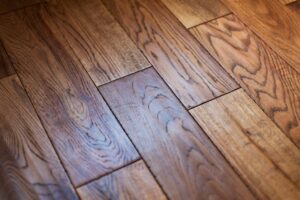 Due to the durability and thickness of the planks, it dramatically increase the lifetime of the flooring. Typically, LVP flooring can last anywhere from 10-20 years depending on the location of the flooring, and thickness installed.
Due to the durability and thickness of the planks, it dramatically increase the lifetime of the flooring. Typically, LVP flooring can last anywhere from 10-20 years depending on the location of the flooring, and thickness installed.
Pros and Cons of LVP
For any type of flooring you install, there are pros and cons. The pros to LVP are they are waterproof, extremely durable with little to no maintenance, easy to install, endless colour way opportunities. The cons to LVP flooring are they can show discoloration when in direct sun for to long.
Ready to look at installing LVP Flooring? Reach out to our team of experts today to look at the best options for your next project! Want to read more about Luxury Vinyl Flooring? Read more in Houzz.
Home Reno: When Should You Get Your New Flooring Installed?
Are you starting a home renovation project? It is important to plan your project in advance and cover all the bases to avoid any costly mistakes as you complete the home renovation. In planning your project, you can define your goals, scope of work, and desired outcome and use these to manage your budget effectively. Knowing your goals, scope of work, and desired outcome will allow you to establish a realistic budget, identifying relevant costs and allocating funds properly. Furthermore, having a clear scope of work will help you prioritize expenses and make informed decisions on materials and labor requirements. With a well-developed project plan, you can clearly and effectively communicate your ideas and requirements to professionals and schedule different services that your home renovation project will require.
With that said, if you plan to install new flooring, you might be wondering at which stage of your project to get this done. While each home renovation project is different, in general, it is recommended that flooring be installed after all structural, electrical, and plumbing work are completed and before beginning painting, trim installation, and other finishing touches.
Install new flooring after completing plumbing and electrical work
By completing plumbing and electrical work at an earlier stage of your home renovation project, you can ensure easier access to the subfloor and walls. As plumbing and electrical work typically involve drilling, cutting, or making openings in walls and floors, your contractors can work without obstructions or the need to cut into newly installed flooring. Furthermore, installing flooring after plumbing and electrical work can minimize the risk of potential damage, such as scratches, punctures, or particle accumulation, on the new flooring.
By installing flooring after completing plumbing and electrical work, you can achieve a seamless and neat finish for your floors and attain your desired outcome for your home renovation project.
Prepare the subfloor and walls prior to installing new flooring
Before installing new flooring, it is important to inspect and prepare the subfloor first. Check the subfloor for any damage, unevenness, or moisture issues, so that these can be repaired or replaced prior to flooring installation. If the subfloor has uneven or rough areas, it may need to be smoothed and leveled as well. By preparing the subfloor prior to new flooring installation, you can create a suitable environment and set the stage for a smooth and successful flooring installation.
Depending on the new flooring to be installed, you might also need to remove and replace the trims and baseboards. Removing the trims and baseboards should be done before installing the new flooring. It is also important to make any repairs to walls prior to flooring installation. If the walls have cracks, holes, or dents, be sure to repair the walls first. Some parts of the wall may need to be sanded or smoothed before painting, and the walls may need to be cleaned to remove any dirt, dust, or debris prior to painting. Complete any tasks to prepare walls for painting, such as priming the walls, before installing new flooring to avoid damaging the new floors. Preparing the walls for painting before installing new floors will help prevent damages, such as scratches, scuffs, dust, and debris, to the new floors.
Install new flooring prior to painting and making finishing touches
Installing new flooring before painting will allow you to have a smooth surface to walk on. Completing the new floor installation first will ensure that the flooring is properly aligned and can help avoid potential damage or disruption caused by painting work. A common concern about painting after installing new flooring is potentially damaging the new floors with paint. With that in mind, prior to painting any surface, be sure to mask the new flooring with the appropriate material to protect it from any spills or stains. Working with experienced professionals will help you ensure that your new flooring will be protected during the painting process.
Moreover, if painting is done prior to floor installation, there is a risk that the bottom edges might not be painted to perfectly align to the height of the new flooring. By painting after flooring installation, you can efficiently paint the walls to align precisely with the flooring edges, creating a seamless and visually appealing finish. Furthermore, you can ensure that your paint job will not be damaged if painting is done after the installation of new flooring. Completing finishing touches such as adding new trims and baseboards will help give your home renovation project a cohesive and polished look.
It is important to note that the specific sequence to complete renovation tasks may vary depending on the scope of work and the materials used for the home renovation project and the recommendations of the professionals involved. Working with professionals with experience and expertise will help you ensure that the proper precautions and protections are in place, so that prior work is not damaged as you complete various stages of your home renovation project. When it comes to new flooring installation, be sure to consult with professionals to understand any installation requirements specific to your desired type of flooring and to get their recommendations to help you achieve your desired home renovation outcome.
Choosing the Right Flooring for Your BBQ Space
When it comes to designing the ideal outdoor barbeque environment, the grill, sitting area, and overall aesthetics are frequently prioritized. The flooring, on the other hand, is sometimes disregarded yet plays a critical part in the overall usefulness and aesthetic of the room. The correct flooring may improve the mood, offer durability, and assure the chef's and visitors' safety. As a result, it is critical to carefully evaluate a variety of aspects while picking the best flooring for your BBQ area.
Assess Climate and Weather Conditions
When it comes to choosing the right flooring for your BBQ area, one important factor to consider is the temperature and weather conditions in the region. This phase is critical in ensuring that the chosen flooring material can resist the environmental elements to which it will be subjected. Weather patterns vary by location, including high humidity, extreme heat, and significant rainfall. Understanding the local environment allows you to select the best flooring material for your BBQ area. It is critical to pick moisture-resistant flooring materials in places prone to high humidity or regular rain. This consideration aids in the prevention of water seepage, mould growth, and warping damage. Because of their natural moisture resistance, porcelain tiles and concrete are great candidates in such situations. The flooring material should be heat-resistant in areas characterized by blistering heat. This feature prevents the floor from becoming very heated, making it difficult to walk on and perhaps leading to burns. Stone or pavers are attractive choices in hot regions because of their high heat tolerance. Understanding the frequency and intensity of weather variations is also aided by climate assessment. If your location sees high temperature swings or weather conditions, selecting a flooring material that can resist these changes without degrading or breaking is critical. In such cases, materials such as concrete and natural stone are more resistant. Furthermore, considering the environment might help you choose a flooring material that requires less upkeep. Materials that are resistant to stains and mold development are very desired in locations with significant rainfall or high humidity. In the long term, this consideration saves you time and work while cleaning and maintaining the flooring.
Durability
To begin with, a BBQ area is susceptible to significant foot traffic and a variety of activities. It is a meeting place for friends and family, where people can move around, socialize, and enjoy the great cuisine that is being prepared. Furthermore, spills, grease, and other undesirable stains may occur in the BBQ area, wreaking havoc on the floor's condition. As a result, selecting a long-lasting flooring material is critical. A long-lasting floor can resist the wear and tear of continual foot activity. It is resistant to scratches, dents, and other wear and tear caused by heavy use. By selecting a flooring material that can withstand such heavy activity, you ensure that your BBQ area will stay functional and visually appealing for an extended length of time. A resilient floor is also simple to maintain, saving you time and effort. Cleaning up after a BBQ may be a time-consuming process, especially if the floor is prone to stains or requires special care. Cleaning is much easier with a long-lasting flooring material, such as concrete or tiles. These materials are well-known for their stain resistance and simplicity of upkeep, allowing you to swiftly clean up any spills or accidents. Durability also helps to your BBQ space's long-term cost-effectiveness. While some flooring materials may be more expensive at first, they frequently provide considerable long-term savings. Investing in a long-lasting floor means you won't have to worry about costly and time-consuming repairs or replacements. By choosing a material that can resist the demands of your BBQ area, you assure that your investment will pay off in the long run.
Safety
Slips and falls are one of the most serious safety problems in a BBQ area. This is especially true while cooking outside, as spills are usual and surfaces can become damp or oily. It is critical to select a flooring material with a high coefficient of friction to reduce the possibility of accidents. Textured materials, such as non-slip tiles or natural stone with a rough texture, improve traction and grip, lowering the risk of slips even when the floor is wet. Another thing to think about is heat resistance. Hot grills, charcoal, and open flames are frequently used in a BBQ area. Contact with heated surfaces by accident might result in burns and injuries. Choosing heat-resistant flooring materials can considerably lower the likelihood of accidents. Concrete, for example, has considerable heat resistance and can bear grilling temperatures. By selecting a heat-resistant flooring material, you create a safer atmosphere for both the chef and the visitors, reducing the risk of burns and guaranteeing peace of mind. Additionally, the arrangement and style of the flooring can add to the safety of the BBQ area. It is critical to maintain a clean and unobstructed channel for foot traffic. Accidents can be avoided by avoiding uneven surfaces, rapid level changes, and tripping hazards. Smooth transitions between portions of the room, such as the kitchen, dining area, and seating area, increase ease of movement and lessen the chance of stumbling. Furthermore, integrating sufficient lighting along paths and steps can improve visibility, particularly during evening events, therefore increasing safety. Children and pets are frequently present in outdoor BBQ areas, making safety precautions even more important. It is critical to consider the requirements of these vulnerable persons while choosing flooring. Choosing a flooring material that is both slip-resistant and soft underfoot might give additional safety for youngsters who are playing or running around the room. Rubberized surfaces or fake grass can provide cushioning and reduce the force of falls, offering a safer environment for children. Similarly, ensuring that the flooring is pet-friendly, with scratch-resistant and easy-to-clean materials, will prevent mishaps and potential harm to furry family members.
Aesthetic Appeal
Aesthetics are important in determining the atmosphere and ambience of any environment, particularly outdoor settings. Your grilling area should be welcoming, comfortable, and visually appealing to you and your visitors. The flooring you choose might help you achieve the ideal atmosphere greatly. By taking into account the visual appeal, you can design a place that matches your unique style while also improving the overall attractiveness of your outdoor cooking area. The flooring material should correspond to the chosen style or concept. There are different flooring alternatives available to fit your preferences, whether you choose a rustic, modern, or classic style. Polished concrete floors or large-format porcelain tiles, for example, can give a clean and minimalist appeal if you are striving for a contemporary and streamlined design. These materials provide a sleek and stylish appearance that fits modern BBQ areas. If you like a more natural and organic vibe, there are materials that may help you accomplish that as well. Slate or granite, for example, may give warmth and beauty to the area. These materials frequently have earthy tones and distinct textures that provide a sense of connectedness to nature. Furthermore, wood decking may give a cozy and appealing atmosphere, making it ideal for a rustic or classic BBQ area. The natural grain patterns and warm tones of wood may provide a welcome and comfortable ambiance for your outdoor cooking and dining activities. The flooring should also complement the other features of your BBQ area. It should compliment your colour scheme, outdoor furniture design, and any other existing characteristics. You may create a coherent and aesthetically appealing outdoor space by selecting flooring that complements the overall design concept. If your BBQ space has a vivid and tropical theme, for example, choosing flooring with colours that suit the brilliant hues of the surrounds may create a cohesive and harmonious aesthetic.
Budget
One of the most important elements to consider when planning and creating a BBQ area is the budget. Considering your budget is critical for selecting the correct flooring that matches your budgetary constraints without sacrificing quality or utility. Setting a realistic budget from the start prevents overpaying and ensures that funds are allocated to all parts of your outdoor cooking area, including the flooring. It enables you to investigate flooring possibilities that are within your budget, avoiding unpleasant surprises or financial hardship during the process. When planning a budget, keep in mind that the expense of flooring extends beyond the first purchase. You should also factor in installation expenses, ongoing maintenance, and any future repairs or replacements. While certain materials may be more expensive up front, they may save money in the long run owing to their longevity and minimal maintenance requirements. You may focus on flooring materials that are within your budget by creating a budget. There are several alternatives accessible, ranging from low-cost solutions to more luxury and pricey ones. If you have a restricted budget, for example, materials like concrete or specific types of tiles might provide affordability without losing usefulness or beauty. It is critical to achieve a balance between price and quality. While it may be tempting to choose the cheapest flooring choice available, it is critical to consider the long-term consequences. Low-priced materials may be more prone to breakage, wear, and discoloration, necessitating frequent repairs or replacement, which might cost you more in the long term. It is worthwhile to invest in higher-quality materials that are durable, easy to maintain, and long-lasting. It is also useful to conduct research and compare pricing from various providers or stores. Prices can vary, and by shopping around, you may be able to discover better prices or promotional offers that will allow you to keep within your budget while still attaining the ideal flooring for your BBQ space. When dealing with a restricted budget, it is critical to prioritize your needs and make sound judgements. Consider your BBQ space's individual requirements, such as climatic resistance, safety features, and aesthetic appeal. Concentrate on locating items that meet these specifications while remaining inside your budgetary limits.
To summarize, choosing the best flooring for your BBQ area necessitates careful consideration of climate, durability, safety, aesthetics, and money. Considering the local weather conditions, choosing durable and low-maintenance materials, emphasizing safety measures, and matching the flooring to the desired design can all help to create a practical and visually beautiful outdoor cooking area. Remember that the flooring is the foundation that supports all other parts of your BBQ space, so pick wisely and enjoy the ideal combination of usefulness and beauty.

